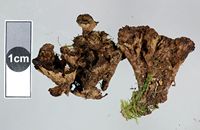|
 Thelephora terrestris Thelephora terrestris
BiostatusPresent in region - Exotic
Images (click to enlarge)
Owner: J.A. Cooper |
Article: Cunningham, G.H. (1963). The Thelephoraceae of Australia and New Zealand. New Zealand Department of Scientific and Industrial Research, Bulletin 145: 359 p. Wellington:.
Description: Hymenophore annual,
membranous, humicolous, sometimes encrusting living or dead plants, forming
pilei of diverse shapes and sizes. Pilei applanate, flabelliform, sometimes
merged to form erect rosettes, 1-10 cm tall and broad; surface ferruginous or
umber, covered with strigose tufts which are concolorous or darker and sometimes
imbricated hymenial surface ferruginous or umber, often vinaceous, radiately
striate, even or finely tuberculate; margins crenate, sometimes freely lobed or
toothed, bluntly rounded or torn, concolorous. Context 1-5 mm thick,
ferruginous, basal layer forming the greater part of the fructification, of
loose parallel hyphae associated with parallel strands of closely compacted
hyphae; generative hyphae 4-6 µm diameter, walls 0.2-0.5 µm thick, pallid yellow
brown, naked, freely branched often at a wide angle, septate, with clamp
connections. Hymenial layer to 90 µm deep, a close palisade of basidia and
paraphyses. Basidia subclavate, 32-45 x 8-10 µm, bearing 2-4 spores; sterigmata
arcuate, to 8 µm long. Paraphyses subclavate, 22-35 x 6-8 µm. Spores subglobose
or irregularly oval, 8-10 µm diameter, or 8-11 x 7-9 µm, walls sinuate, finely
sparsely verruculose, pallid ferruginous, 0.5 µm thick.
Habitat: HABITAT: Encrusting humus under pines.
Distribution: DISTRIBUTION:
Cosmopolitan.
Notes: Although only
a few collections are listed, the species may be found in any plantation of
Pinus radiata. It has evidently been introduced with seeds or plants,
since it is not found in any other habitat. There is no evidence showing that
the fungus forms a mycorrhiza with pines; nor is the species a plant parasite,
though known occasionally to kill pine seedlings by growing around stems and
smothering them. In macrofeatures the species varies so considerably that it is
difficult to draw an accurate description of the fructifications. Commonly
plants grow over pine needles, humus, and soil under pines, the mycelium
encrusting the surface over an area of many square metres. From the mycelium
pilei arise. Usually flabelliform, they may merge to form erect rosettes, or
sometimes campanulate pilei.
T. crustosa was
erected on a form with small flabelliform fructifications. Pilei may remain
entire; or more commonly become torn into few or several lobes, T.
laciniata being a name applied to specimens displaying the latter
condition. Colour may range from ferruginous to dark umber, or umber with a
vinaceous tinge; the pileus surface may be clothed with coarse strigose tufts,
slender down-pressed bundles of hairs, or remain almost smooth. The hymenial
surface may be even, or, as often tuberculate or radially striate. Most
conditions may be found in one ample collection, showing that these are merely
variable growth conditions. Spores are subglobose or more often oval, walls
bearing 3-5 rounded lobes, giving them a sinuate appearance. Spore walls are
covered with short, scanty, broad-based verruculae, which may be hyaline or
tinted brown like the spore wall.
Article: Gadgil, P.D. (in association with Dick, M.A.; Hood, I.A.; Pennycook, S.R.) (2005). Fungi on trees and shrubs in New Zealand. Fungi of New Zealand. Ngā Harore o Aotearoa 4: xi + 437 p. Hong Kong: Fungal Diversity Press.
Description: Type: Mycorrhizal Fungi; Description: Basidiomata formed from subsessile pilei of diverse shape and form, dimidiate or spuriously infundibuliform, often in imbricating rosettes, up to 120 mm wide, sometimes encrusting living or dead plants. Pilei applanate, flabelliform, surface ferruginous, umber or vinaceous, covered with strigose tufts, margin crenate, concolorous. Pore surface inferior, even or finely tuberculate, ferruginous, umber or vinaceous. Context ferruginous, 1–5 mm thick, fibrous. Basidiospores either globose 8–10 μm in diameter, or irregularly oval, 8–11 × 7–9 μm, 0-septate, sparsely echinulate, pallid ferruginous.
Distribution: Distribution: Northland, Bay of Plenty, Taupo, Wanganui, Gisborne, Hawkes Bay, Nelson, Buller, North Canterbury, Mid Canterbury, South Canterbury, Dunedin, Otago Lakes, Southland.; 1st Record: Chu-Chou (1979).
Notes: Notes: This fungus has been also recorded under ‘Radicicolous Basidiomycota’ because it is a root-inhabiting fungus that occasionally smothers young seedlings. The following account contains additional information relating to its mycorrhizal function. ASSOCIATED PLANTS: Pinus radiata, Pseudotsuga menziesii.
|